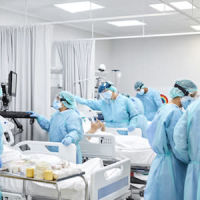COVID-19 has resulted in the death of over 4 million people worldwide. In severe cases of COVID-19, acute respiratory infection leads to severe pneumonia, which worries to progress hypoxaemia and acute respiratory distress syndrome (ARDS).
Prolonged sessions in the prone position is an effective intervention to decrease mortality in these patients. It has been adopted for the treatment of C-ARDS, both before intubation and during invasive ventilation. Observational studies show prone positioning improves oxygen and decreases mortality rate in patients with C-ARDS. However, the mechanisms of these effects remain unclear.
In this study, researchers assessed the physiologic effects of pronation using CT scan and electrical impedance tomography (EIT). The goal was to characterise the physiologic effects of prone position on the key mechanisms of regional lung protection, including recruitment, reduced atelectrauma, and improved ventilation-perfusion matching.
Twenty-one intubated patients with moderate or severe C-ARDS in an Italian dedicated COVID-19 ICU were included in the analysis. Patients were transported to a CT scan facility where images were acquired in prone and supine position. Gas exchange, respiratory mechanics, and ventilation and perfusion EIT-based analysis were also provided back in the ICU toward the end of two 30 minutes steps.
CT scan analysis showed that the nonaerated lung weight decreased significantly in the prone position. Prone position increased the normally aerated lung weight and significantly decreased hyperinflated tissue. Recruitment induced by prone position was significant.
Data from EIT showed that recruitment in the dorsal region induced increased regional ventilation and the ventral derecruited lung was characterised by reduced ventilation. Prone position did not affect the fraction of mismatched units but significant decreased dead space/shunt ratio.
Prone positioning did not induce any change in respiratory mechanics. However, oxygenation improved and calculated pulmonary shunt decreased. No difference was observed in Pao2/Fio2 nor ventilatory ratio between values at enrollment and during the study in the supine position after the cycle of pronation.
Despite mild derangement of respiratory mechanic and preserved lung aeration in the supine position, prone position induced alveolar recruitment in the dorsal regions. Alveolar derecruitment occurred in the ventral lung regions. Also, Doral recruitment reduced the risk of regional atelectrauma
These findings show several changes that are associated with prone position in C-ARDS. These include increased lung recruitment, decreased atelectrauma, and improved ventilation-perfusion matching.
Source: Critical Care Medicine
Image Credit: iStock
References:
Fossali T, Pavlovsky B, Ottolina D et al. (2022) Effects of Prone Position on Lung Recruitment and Ventilation-Perfusion Matching in Patients With COVID-19 Acute Respiratory Distress Syndrome: A Combined CT Scan/Electrical Impedance Tomography Study. Critical Care Medicine. 50(5):723-732.
Latest Articles
ARDS, acute respiratory distress syndrome, COVID-19, prone position, C-ARDS
Effect of Prone Position C-ARDS



























